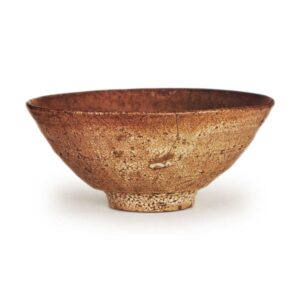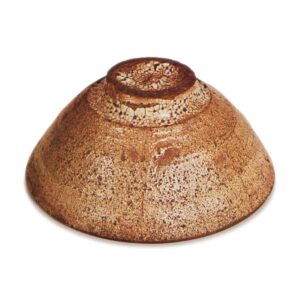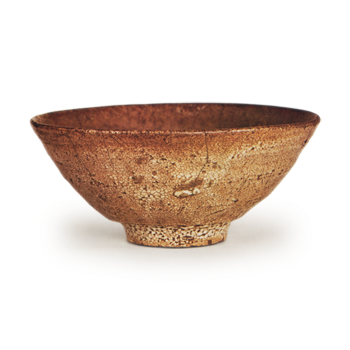

Height: 6.7-7.2cm
Diameter: 15.3-15.7cm
Outer diameter of foot ring: 5.5cm
Height of foot ring: 1.0cm
There are teacups that are difficult to distinguish between large wells, small wells and blue wells. The Nara well that was passed down in the Kuroda family is an example of this, and it has a shallow, flat shape similar to the small well Uji and the blue well Shibata and Kumoi. However, there are also shallow, flat tea bowls like the famous Tei-do tea bowls from Sakamoto and Kokonoe, and Nara is traditionally considered to be the home of the famous Tei-do tea bowl.
Nara does not have the interesting foot-rings of Kizaemon, the imposing style of Tsutsui-tsutsumi, or the harmonious, deep atmosphere of Hōju-an. However, it could be said that the beauty of these tea bowls lies in their plain, simple nature. This is a simple, elegant tea bowl with no particular quirks.
The clay is a rough, sandy clay with a slight iron content, and a milky, translucent glaze is applied thickly to it. The base is exposed. The well-dipping is all likely to be done in the raw, but the thickly glazed areas have rough craze, while the areas with a thin glaze have fine craze. The firing is slightly oxidized and has a loquat-colored appearance, but the firing is a little weak and does not melt as well as Tsutsui-Tsutsui or Echigo ware. As a result, the skin feels a little rough, and this is particularly noticeable around the rim and at the bottom, where the kaaragi pattern is visible. The simple rim, the slight bulge in the middle, the strong and unobtrusive wheel marks, and the neat and well-proportioned shape all make this one of the best tea bowls from the large number produced by the Ido kiln.
There are five marks on the inside of the bowl, and the glaze color and tone are almost the same as the outside, but there are also places where the glaze has been applied and then dripped on from a ladle, creating a double glaze in a dripping rain-drop pattern. This is a change in the inside of the bowl that is not seen in many other wells.
The foot ring was scraped with a spatula, and the rough clay where it was scraped has a mottled pattern. The bottom of the inside was also scraped with a spatula, and the hood is standing up. There is a question among potters as to whether the spatula is a wooden spatula or an iron spatula, which is commonly called a “magari” or “kanna”, but I think it is an iron “magari”. A wooden spatula can make a foot ring like Shino, but not like Ido.
There are nearly ten large and small gutters, but there is no fraying, and it is a tea bowl that is almost perfect as an Ido.
It is not known who owned it before it entered the Kuroda family, but in December 1942, it was sold at auction to the Kuroda family for the high price of 123,000 yen. At the time, this was an expensive tea bowl.



